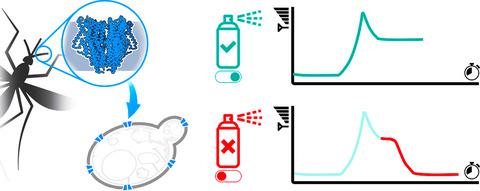当前位置:
X-MOL 学术
›
Microbiologyopen
›
论文详情
Our official English website, www.x-mol.net, welcomes your
feedback! (Note: you will need to create a separate account there.)
A Pichia biosensor for high‐throughput analyses of compounds that can influence mosquito behavior
MicrobiologyOpen ( IF 3.9 ) Pub Date : 2020-12-02 , DOI: 10.1002/mbo3.1139 Julia Nogueira Varela 1 , Vikramaditya G Yadav 1
MicrobiologyOpen ( IF 3.9 ) Pub Date : 2020-12-02 , DOI: 10.1002/mbo3.1139 Julia Nogueira Varela 1 , Vikramaditya G Yadav 1
Affiliation

|
Mosquitoes utilize their sense of smell to locate prey and feed on their blood. Repellents interfere with the biochemical cascades that detect odors. Consequently, repellants are highly effective and resource‐efficient alternatives for controlling the spread of mosquito‐borne illnesses. Unfortunately, the discovery of repellents is slow, laborious, and error‐prone. To this end, we have taken a giant stride toward improving the speed and accuracy of repellant discovery by constructing a prototypical whole‐cell biosensor for accurate detection of mosquito behavior‐modifying compounds such as repellants. As a proof‐of‐concept, we genetically engineered Pichia pastoris to express the olfactory receptor co‐receptor (Orco) of Anopheles gambiae mosquitoes. This transmembrane protein behaves like a cationic channel upon activation by stimulatory odorants. When the engineered Pichia cells are cultured in calcium‐containing Hank's buffer, induction of the medium with a stimulatory odorant results in an influx of calcium ions into the cells, and the stimulatory effect is quantifiable using the calcium‐sequestering fluorescent dye, fluo‐4‐acetoxymethyl ester. Moreover, the stimulatory effect can be titrated by adjusting either the concentration of calcium ions in the medium or the level of induction of the stimulatory odorant. Subsequent exposure of the activated Pichia cells to a repellant molecule inhibits the stimulatory effect and quenches the fluorescent signal, also in a titratable manner. Significantly, the modular architecture of the biosensor allows easy and efficient expansion of its detection range by co‐expressing Orco with other olfactory receptors. The high‐throughput assay is also compatible with robotic screening infrastructure, and our development represents a paradigm change for the discovery of mosquito repellants.
中文翻译:

毕赤酵母生物传感器,用于对影响蚊子行为的化合物进行高通量分析
蚊子利用嗅觉来定位猎物并吸食猎物的血液。驱虫剂会干扰检测气味的生化级联反应。因此,驱虫剂是控制蚊媒疾病传播的高效且资源高效的替代品。不幸的是,驱虫剂的发现过程缓慢、费力且容易出错。为此,我们通过构建原型全细胞生物传感器来准确检测驱虫剂等蚊子行为改变化合物,在提高驱虫剂发现的速度和准确性方面迈出了一大步。作为概念验证,我们对毕赤酵母进行了基因改造,以表达冈比亚按蚊的嗅觉受体辅助受体 (Orco) 。这种跨膜蛋白在被刺激性气味剂激活后表现得像阳离子通道。当工程化的毕赤酵母细胞在含钙的 Hank's 缓冲液中培养时,用刺激性气味剂诱导培养基会导致钙离子流入细胞,并且可以使用钙螯合荧光染料 Fluo-4 来量化刺激效果‐乙酰氧基甲酯。此外,可以通过调节培养基中钙离子的浓度或刺激性气味剂的诱导水平来滴定刺激效果。随后将活化的毕赤酵母细胞暴露于驱避剂分子,同样以可滴定的方式抑制刺激作用并淬灭荧光信号。值得注意的是,生物传感器的模块化架构可以通过与其他嗅觉受体共表达 Orco 来轻松有效地扩展其检测范围。高通量测定还与机器人筛选基础设施兼容,我们的开发代表了驱蚊剂发现的范式变化。
更新日期:2021-02-02
中文翻译:

毕赤酵母生物传感器,用于对影响蚊子行为的化合物进行高通量分析
蚊子利用嗅觉来定位猎物并吸食猎物的血液。驱虫剂会干扰检测气味的生化级联反应。因此,驱虫剂是控制蚊媒疾病传播的高效且资源高效的替代品。不幸的是,驱虫剂的发现过程缓慢、费力且容易出错。为此,我们通过构建原型全细胞生物传感器来准确检测驱虫剂等蚊子行为改变化合物,在提高驱虫剂发现的速度和准确性方面迈出了一大步。作为概念验证,我们对毕赤酵母进行了基因改造,以表达冈比亚按蚊的嗅觉受体辅助受体 (Orco) 。这种跨膜蛋白在被刺激性气味剂激活后表现得像阳离子通道。当工程化的毕赤酵母细胞在含钙的 Hank's 缓冲液中培养时,用刺激性气味剂诱导培养基会导致钙离子流入细胞,并且可以使用钙螯合荧光染料 Fluo-4 来量化刺激效果‐乙酰氧基甲酯。此外,可以通过调节培养基中钙离子的浓度或刺激性气味剂的诱导水平来滴定刺激效果。随后将活化的毕赤酵母细胞暴露于驱避剂分子,同样以可滴定的方式抑制刺激作用并淬灭荧光信号。值得注意的是,生物传感器的模块化架构可以通过与其他嗅觉受体共表达 Orco 来轻松有效地扩展其检测范围。高通量测定还与机器人筛选基础设施兼容,我们的开发代表了驱蚊剂发现的范式变化。











































 京公网安备 11010802027423号
京公网安备 11010802027423号